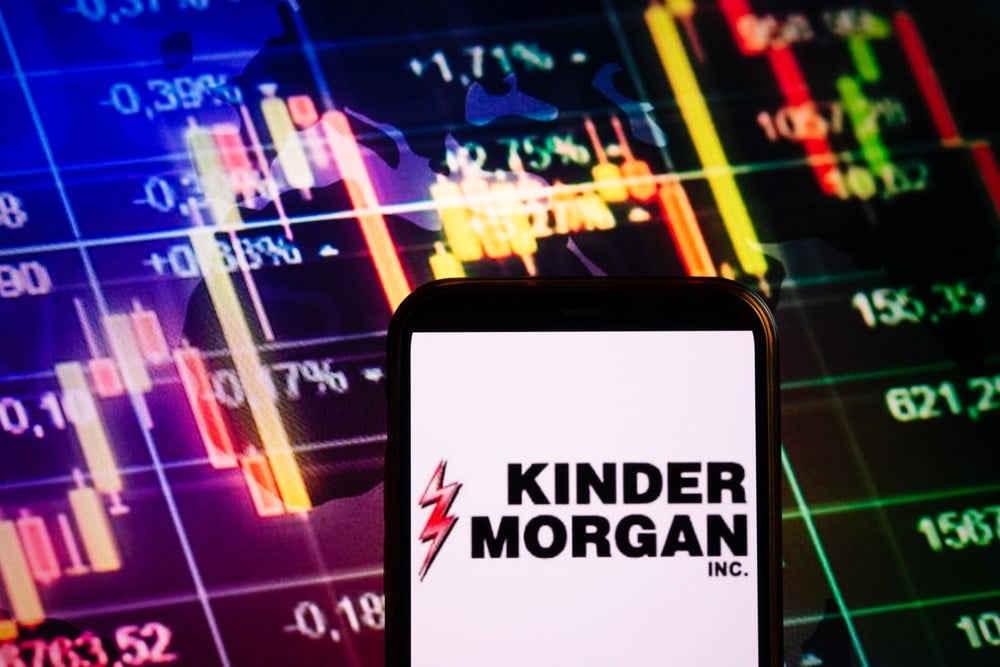
Shares of oil-and-gas infrastructure specialist Kinder Morgan Inc. (NYSE: KMI) are consolidating below a potential buy point north of $20.20.
The stock got an initial boost after its second-quarter report on July 19, but is now essentially flat after declining for two weeks.
Earnings came in at $0.24 a share, down 11% from a year ago. Revenue was $3.501 billion, down 32%.
MarketBeat’s Kinder Morgan earnings data show the company met earnings views but missed on the revenue side.
Lower Commodity Prices
There was more bad news: In the earnings release, the company said that it’s on budget year-to-date, but now expects to finish 2023 slightly below its plan on a full-year basis, “all of which can be explained by expected lower commodity prices”
It added that crude oil and natural gas prices have been below its full-year budget assumptions of $85 per barrel and $5.50 per one million British thermal units, respectively.
“We do expect strong performance in our overall business to partially offset the weaker pricing,” the company said.
However, the company is a leader in its market, meaning it has considerable wiggle room despite commodity prices. It’s pursuing other projects that it expects to contribute to this year’s results.
Strong Free Cash Flow Generation
There are some metrics that continue to make the stock attractive to investors: For example, in the most recent quarter, the company generated more than $1 billion in free cash flow.
Also, the company’s dividend yield is 6.5%, and it has a six-year track record of boosting its shareholder payout, as you can see using MarketBeat’s Kinder Morgan dividend data.
It’s among the top S&P 500 dividend payers, in terms of yield.
Kinder Morgan is structured as a Master Limited Partnership, a type of business entity commonly used in the energy sector. MLPs are often favored by companies involved in energy infrastructure and natural resources because of their unique tax advantages and ability to distribute income to investors.
Kinder Morgan's MLP structure allows it to pass a significant portion of its income directly to its investors without incurring corporate-level taxes. This structure can provide tax benefits and potentially higher yields for investors.
$330 Million In Share Buybacks
The company also returns capital to shareholders via share repurchase. So far this year, it’s repurchased almost 20 million shares for approximately $330.
Since mid-June, the stock has repeatedly found a floor around $16, a good sign that institutional investors are opting to support the stock after a bout of selling.
With a market capitalization of $38.95 billion, Kinder Morgan is one of the largest energy infrastructure companies in North America. Its primary focus is on the transportation, storage, and distribution of various energy products, including natural gas, crude oil, refined petroleum products, and other energy-related commodities.
The company owns and operates an extensive network of pipelines, terminals, and other infrastructure assets. Kinder Morgan's infrastructure plays a crucial role in transporting energy resources from production areas to refineries, processing plants, export facilities, and ultimately to consumers.
Its lines of business include natural gas pipelines, crude oil pipelines, refined petroleum products, terminals and storage, export facilities, and carbon capture and utilization.
Up 14% In 2022
Kinder Morgan advanced 14% in 2022, participating in last year’s energy-sector rally, but at a lesser degree than some other oil-and-gas stocks. However, that hefty dividend payout helps smooth any disappointment regarding price appreciation.
A glance at Kinder Morgan’s institutional ownership data shows: The buyers have clearly been in charge, which bodes well for future returns. In the past 12 months, a total of 964 institutional buyers accounted for $4.87 billion in inflows, versus 640 institutional sellers accounting for $2.11 billion in outflows.
The stock’s up/down volume ratio is 1.4, another indicator of heavier buying than selling. This ratio compares trading volume on up and down days. It can help you evaluate price momentum, confirm trends, and spot potential reversals. It can also provide insights into market sentiment.
You can find the up/down volume ratio using MarketBeat’s Kinder Morgan chart.













